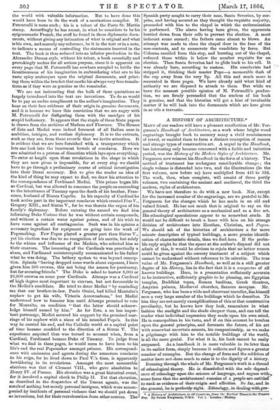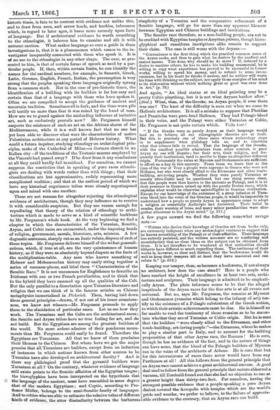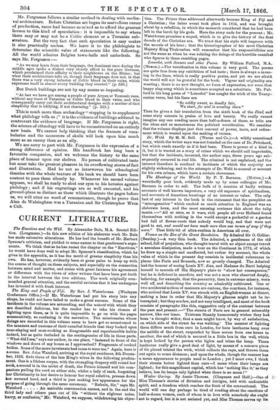A HISTORY OF ARCBTI'ECTURE.*
hasy of our readers wilLhave a pleasant recolleotion of. Mr. Fer- gusson's Handbook of Architecture, as a work whose bright- wood engravings brought back to memory many a vivid reminiscence of travel, or enabled them to form a distinct conception of -unseen and strange types of constructive art. A sequel to the Handbook, lass interesting only because concerned with a feeble and imitative period, was the History-of the Modern Styles of Architecture. Mr. Fergu.sson mow reissues his Handbook in the form of a history. The method of treatment has undergone considerable change ; the single volume is distended into two, and the illustrations (in the first volume, now before us) have multiplied from 441 to 536. The work, then, when -complete, will consist of three portly volumes, two containing the.aneientand mediaeval, the third the modern, styles of .architecture.
We have not therefore to do with .a. new book. Nor, except for the increased number of the engravings, are we grateful to Mr. Ferguson for. the changes which he has made in an old ,and valued friend. Hellas not much that is original to say on the general theory of architecture .as a mechanical and as a fine art. His ethnological speculations appear to us somewhat crude. It would not: e difficult to break ia lance with him on his strange division -of architecture into Heathen, Christian, and Pagan. We should ask of the historian of Architecture a far more minute description of typical buildings, a more precise identifi.- cation of-characteristic details, than we fuel leers. _If the proba- ble reply might -be that the space at the author's disposal did not admit of this, it would be obvious to rejoin that no better reason could be;given against the cursory treatment of .a subject which cannot be understood without reference to its minutiae. The true value of Mr. Fergusson's Handbooki, as.welLas in.a still greater degree of his History, lies in the fact that it is a conspectus of all known buildings. Here, in a presentation sufficiently accurate to -be instructive, sufficientlygraphic to be plene, are Egyptian temples, Buddhist topes, Roman basilicas, Greek theatres, Assyrian palaces, Mediaeval churches, Saracen mosques. Mr. Fergusson, who has been a wide.and observant traveller, lies himself seen a very large number of the buildings which he describes. To
him they .are notmerely exemplifications of this or that constructive peculiarity, but he knows how they look, remembers in what fashion the sunlight and the shade chequer them, and can tell the reader what individual impression they made upon his •own mind.
He is cosmopolitan in his taste, and if on this account he touches upon the general principles,-and forecasts the future, of his art with somewhat uncertainseeents, his companionship, AS we make a pilgrimage with him to the. notable buildings of the world, is.all -the more genial. .For what it is, his book cannot be easily
surpassed. As.a handbook it is -more valuable in its later than in its earlier form, simply because it -collects snd .figures a greater number of examples. But the change of form and the addition of matter have not clone much to raise it to the dignity of a history.
Running through the whole of Mr. Fergusson's work is ntleread
of ethnological theory. He _is .'dissatisfied with the sale -depend- ence of ethnology upon the science of language,- and argues wi some force that the architectural remains of a Teeple are.enti .to rank as evidence:of tbeircrigin And affinities. So far,,and in the general, he is perfectly right. . Ethnolegy, -in dealing with pre- . A History of Architecture, in till'Countries,from the "Warliest-Time4 to 'the 'Present Day. By James Tergusson,.1113.43, Fol. I. London: Murray. historic times , is fain to be content -with evidence not unlike this, and to draw from axes, and arrow heads, and buckles, inferences which, in regard to later ages, it bases more securely upon facts of language. But if architectural evidence be worth something to the ethnologist, it behoves him to examine and sift it with extreme caution. What makes language so sure a guide in these investigations is, that it is a phenomenon which comes to the in- vestigator inseparably connected with those who speak it. It is of no use to the ethnologist in any other shape. The case, as pre- sented to him, is that of certain forms of speech as used by a par- ticular people. If, then, within certain limits, he can identify the names for the cardinal numbers, for example, in Sanscrit, Greek, Latin, German, English, French, Italian, the presumption is very strong that the peoples speaking these languages originally sprang from a common stock. But in the case of pre-historic times, the identification of a building with its builders is far less easy and certain than that of a language with those who have spoken it. Often we are compelled to accept the guidance of ancient and uncertain tradition. Sometimes all is dark, and the time-worn pile will testify no more than that it was raised by the hand of man. How are we to.guard against the misleading influence of imitative art, such as exclusively prevails now? Mr. Fergusson himself suspects the existence of such an art on the. African shores of the Mediterranean, while it is a well known fact that no one has yet been able to discover what were the characteristics of native Palestinian architecture at any period of Hebrew history. What could a future inquirer,• studying ethnology on archmological prin- ciples, make of the Cathedral of Milan—a German church in an Italian city—if the traditions of the Teutonic masons employed by the Visconti had passed away? If he drew from it any conclusions at all they could hardly fail to mislead. For ourselves, we cannot suppress the conviction that in speaking of pure races ethnolo- gists are dealing with words rather than with things ; that their classifications are but approximative, rudely representing more complicated realities ; and that at the earliest period of which we have any historical cognizance tribes were already superimposed upon and mixed with one another.
These are not reasons for altogether rejecting the ethnological evidence of architecture, though they may influence us to receive it with considerable suspicion. But they are reason enough for repudiating that theory of the relation of ethnology to archi- tecture which is made to serve as a kind of scientific backbone to Mr. Fergusson's whole book. At the very beginning we find a chapter in which the characteristics of the Turanian, Semitic, Aryan, and Celtic races are enumerated, under the imposing heads of religion, government, morals, literature, arts, sciences. A few -dogmatic sentences, sharply cut as an Ionic volute, dispose of each of these topics. Mr. Fergusson delivers himself of the widest generali zations, which,. if. Arne at all, are the very quintessence of human history, as if they were as absolutely beyond dispute as the facts of the multiplication-table. Any man who knows something of Hebrew and Mohammedan history may easily string together a series of common-places, and label them " Characteristics of the Semitic Race." it is not uncommon-for Englishmen to describe an Irishman with one or two French peculiarities, and to think that in the hybrid they have summed up all the qualities of the Celt. But the only parallel to a dissertation upon Turanianliterature and religion that we can think of is the famous articles on Chinese metaphysics immortalized in Pickwick. Then, having laid down these general principles—drawn, if not out of his inner conscious- ness, we know not whence—Mr. Sergusson proceeds to apply them to the elucidation of particular cases. Let us see how they vivork. The Turanians and the Celts are the architectural races ; the Semitic and Aryan tribes have no true feeling for art, and do not build. But the Egyptians are among the greatest builders of the world. No more ardent admirer of their ponderous monu- ments than Mr. Fergusson could easily be found. Therefore the
Egyptians are Turanians. All that we know of them proclaims their likeness to the Chinese. But where have we got the major premiss that all Turanians are builders, except from an induction of instances in which nations known from other sources to be Turanian have also developed an architectural faculty ? And is there any philological proof that the pyramid builders were Turanians at all ? On the contrary, whatever evidence of language still exists points to the Semitic affinities of the Egyptian tongue ; the hieroglyphics have been interpreted on the hypothesis that ,!. the language of the ancient, must have resembled in some degree that of the modern Egyptians ; and Coptic, according to Pro- fessor Muller, belongs to the semi-Semitic family of languages. And to critics who-are able to estimate the -relative value of different kinds of evidence, the utter dissimilarity between the barbarous
simplicity of a Turanian and the comparative refinement Of Semitic language, will go for more than any apparent likeness between-Egyptian and'ehinese buildings and institutions.
The Semitic race therefore, as a non-building people, are not to be credited with Egyptian temples orAssyrian palaces, though hiero- glyphical and cuneiform inscriptions alike remain to support their claim. The case is still worse with the Aryans :—
" Convenience is the first thing which the practical common sense of the Aryan seeks, and then to gain what he desires by the readiest and easiest means. This done, why should he do more ? If, induced by a desire to emulate others, he has to make his building ornamental, he is willing to copy what experience has proved to be successful in former works, willing to • spend his money, and to submit to same incon- venience, but in his heart he thinks it-useless, and he neither will waste his time with thinking on the subject, nor apply those energies of his mind to its elaboration without which nothing great or good was ever done in Art." (p. 70.)
And again, " An ideal statue or an ideal painting may be a pretty Celtic plaything, but it is not what A-ryans hanker after." (ibid.) What, then, of the Greeks, an Aryan people, if ever there was one? The knot of the difficulty is soon cut when we come to Hellenic architecture. 'It is all amistake to suppose that Pheidias and Praxiteles were pure-bred Hellenes. They had Pelasgic blood in their veins, and the Pelasgi were either Turanian or. Celtic, :Mr. Fergusson is not quite certain which. Voila tout.!
" the Greeks were as purely Aryan as their language would lead us to believe, all our ethnographic theories are at fault. Bat this is precisely one of those cases where archaeology steps in to supplement what philology tells us, and to elucidate what that science falls to reveal. That the language of the Greeks, with the smallest possible admixture from other sources, is pure Aryan no one will dispute ; but their arts, their religion, and fre- quently their institutions, tend to ascribe to them an altogether different origin. Fortunately the ruins at Mycente and Orchomenos are sufficient to afford us a .key to this mystery. From them we learn that- at the time of the war of Troy a people were supreme in Greece who were not Hellenes, but who were closely allied to the Etruscans and other tomb- building, art-loving -people. Whether they were purely 'Turanian or merely ultra-Celtic may be qaestioned, but one thing seems clear, that this people were then known to the ancients as Pelasgi, and it is to their presence in Greece, mixed up with the purely Dorian races, which explains what would be otherwise unintelligible in Grecian civilization. Except for our knowledge of the existence of a stray infusion of Tura- nian blood into the veins of the Grecian people, it -would be impossible to understand how a people so purely Aryan in appearance came to adopt a religion so essentially Anthropic and Ancestral. Their belief in oracles, their worship of trees, and many minor peculiarities were alto- gether abhorrent to the Aryan mind." (p. 211.) A few pages onward we find the following somewhat savage note:— "Writers who derive their knowlege of Grecian art from books only, are extremely indignant when any technologist ventures to suggest that he knows something of the Pelasgi or -of thairaffinities. Theirlanguage has entirely perished, and the written accounts are so conflicting and unsatisfactory that no clear. ideas on• the subject can be obtained from them. It is not therefbre to be wondered at that authorities should hitherto have differed so much regarding them. "The testimony of their works is, however, so clear and distinct, that the' bookworms would =do well to keep their .tempers till :at least they have mastered -and cam refute it." (p.212.) Keeping our temper, then, as becomes a bookworm, if not-always van architect, how does the case stand? Here is a people who have -reached the height of excellence in at least two arts, archi- tecture and sculpture. Their language is admitted to be emphati- cally Aryan. The plain inference seems to be that the alleged inaptitude of the Aryan races for the fine arts is at all events not universal. But no, says Mr. Fergusson, the remains at Mycenm and Orohomenos (remains which belong to the infancy of .art) -tes- tify to the existence of a .Pelasgic substratum of the Greek nation, to which their artistic achievements must be due. He is himself rso far.unable to road the testimony of those remains as to he uncer- tain whether they are of Turanian or Celtic origin. But he.is 'sure that the builders " were closely allied to the Etruseaus, and other tomb-building, art-loving people :"—the Etruscans, whom he makes to play a similar part in Italy, and to account far the-building propensities of that other Aryan race, the Romans ! He is sure, though he has no evidence of the fact, and in the nature of things can have none, that the blood of the Pelasgic builders of Nycence ran in the veins of the architects of Athens. He is sure that but for this intermixture of races there never would have been any Parthenon at all 1 All this follows from the general principle that an Aryan race cannot achieve a great architectural success. .A good deal -used to follow from the general principle that nature abharred a vacuum, till Torricelli found out that she had no objection to one at a greater height than thirty-two. feet. For ourselves, having the strongest possible evidence that a people speaking a pure Aryan dialect covered the 'Acropolis with temples which are the world's pride and wonder, we prefer to believe, in the' ailure of- apprecia- able evidence to the contrary, that an `Aryan race can build.
Mr. Fergusson follows a similar method in dealing with mediae- val architecture. Before Christian art began its marvellous career of production, races had become so mixed as to afford the greatest licence to this kind of speculation : it is impossible to say where there may or may not be a Celtic element or a Turanian sub- stratum. But the very fact that such speculation is easy makes it also practically useless. We leave it to the philologists to determine the scientific value of statements like the following.
All the world admires Belgian town-halls and cathedrals. So says Mr. Fergusson :-
" As we may learn from their language, the dominant race during the middle ages spoke a dialect very closely allied to the pure German, which proclaimed their affinity to their neighbours on the Rhine ; but what their architecture tells us, though their language does not, is that there was a very strong infusion of Celtic blood in their veins, which expresses itself in almost every building they erected." (p. 536.)
But Dutch buildings are not by any means so imposing.
"At last we have got among a people of pure Aryan or Teutonic race, without any trace of Turanian or Celtic blood in their veins, and who consequently carry out their architectural designs with a matter-of-fact simplicity that is edifying, if not charming." (p. 555.)
This is much more than archaeology" stepping in to supplement what philology tells us ;" it is the evidence of buildings adduced to controvert the evidence of language. If Mr. Fergusson is right, the science of ethnology will have to be reconstructed on an entirely new basis. We cannot help thinking that the framers of voca- bularies and the measurers of skulls will look upon him much more as an enemy than as an ally.
We are sorry to part with Mr. Fergusson in the expression of a strong difference of opinion. His handbook has long been a favourite companion, and we welcome the history to the same place of honour upon our shelves. No person of cultivated taste but must take the greatest pleasure in its overflowing stores of fact and illustration. Had he not so interwoven his ethnological theories with the whole texture of his book we should have been content to pass them silently by. Whenever his second volume appears, we shall be ready to shut our eyes to his heresies against philology ; and if his engravings are as well executed, and his ground-plans as distinct as those which illustrate the pages before
us, we will utter no word of remonstrance, though he prove that Alan de Walsingham was a Turanian and Sir Christopher Wren a Celt.
































 Previous page
Previous page